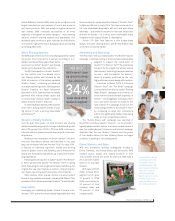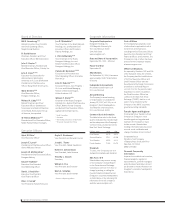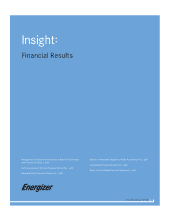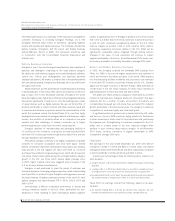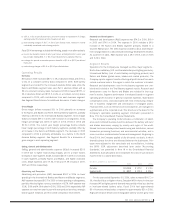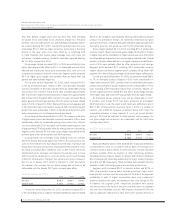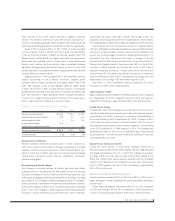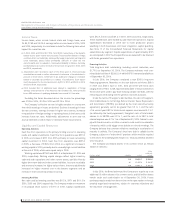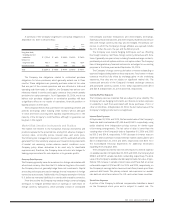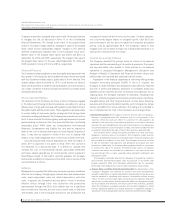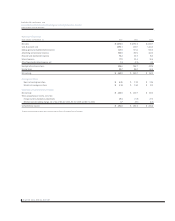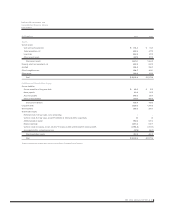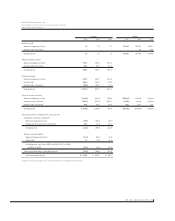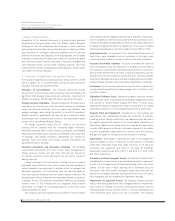Energizer 2006 Annual Report Download - page 18
Download and view the complete annual report
Please find page 18 of the 2006 Energizer annual report below. You can navigate through the pages in the report by either clicking on the pages listed below, or by using the keyword search tool below to find specific information within the annual report.
ENERGIZER HOLDINGS, INC.
Management’s Discussion and Analysis of Results of Operations and Financial Condition
(Dollars in millions, except per share and percentage data)
16 ENR 2006 ANNUAL REPORT
Company entered into a prepaid share option with a financial institution
to mitigate this risk as discussed in Note 13 to the Consolidated
Financial Statements. The change in fair value of the prepaid share
option is recorded in SG&A expense. Changes in value of the prepaid
share option should substantially mitigate changes in the after-tax
deferred compensation liabilities tied to the Company’s stock price.
Market value of the prepaid share option was $50.8 and $20.4 at
September 30, 2006 and 2005, respectively. The change in fair value of
the prepaid share option for the year ended September 30, 2006 and
2005 resulted in income of $10.8 and $5.4, respectively.
Seasonal Factors
The Company’s battery segment results are significantly impacted in the
first quarter of the fiscal year by the additional sales volume associated
with the December holiday season, particularly in North America. First
quarter battery sales accounted for 31% of total battery net sales in
2006, 2005 and 2004. In addition, natural disasters, such as hurricanes,
can create conditions that drive exceptional needs for portable power
and spike battery sales.
Environmental Matters
The operations of the Company, like those of other companies engaged
in the battery and shaving products businesses, are subject to various
federal, state, foreign and local laws and regulations intended to protect
the public health and the environment. These regulations primarily relate
to worker safety, air and water quality, underground fuel storage tanks
and waste handling and disposal. The Company has received notices from
the U.S. Environmental Protection Agency, state agencies and/or private
parties seeking contribution, that it has been identified as a “potentially
responsible party” (PRP) under the Comprehensive Environmental
Response, Compensation and Liability Act, and may be required to
share in the cost of cleanup with respect to seven federal “Superfund”
sites. It may also be required to share in the cost of cleanup with
respect to two state-designated sites or other sites outside of the U.S.
Accrued environmental costs at September 30, 2006 were $8.3, of
which $1.9 is expected to be spent in fiscal 2007. This accrual is
not measured on a discounted basis. It is difficult to quantify with
certainty the cost of environmental matters, particularly remediation
and future capital expenditures for environmental control equipment.
Nevertheless, based on information currently available, the Company
believes the possibility of material environmental costs in excess of the
accrued amount is remote.
Inflation
Management recognizes that inflationary pressures may have an adverse
effect on the Company, through higher material, labor and transportation
costs, asset replacement costs and related depreciation, and other
costs. In general, the Company has been able to offset or minimize
inflation effects through other cost reductions and productivity
improvements through mid-2005, thus inflation was not a significant
factor to that point. Recently, the cost of zinc, nickel, steel, oil and other
commodities used in the Company’s production and distribution has
increased to levels well above those of prior years. Of these materials,
zinc is by far the largest impact on Energizer’s profit. Each $0.01 per
pound increase in the zinc price increases the Company’s annualized
pre-tax costs by approximately $0.8. The Company’s ability to fully
mitigate such cost increases through cost cutting and productivity or to
raise prices in the future are not certain.
Critical Accounting Policies
The Company identified the policies below as critical to its business
operations and the understanding of its results of operations. The impact
and any associated risks related to these policies on its business
operations is discussed throughout Management’s Discussion and
Analysis of Results of Operations and Financial Condition where such
policies affect the reported and expected financial results.
Preparation of the financial statements in conformity with generally
accepted accounting principles (GAAP) in the U.S. requires the
Company to make estimates and assumptions that affect the reported
amounts of assets and liabilities, disclosure of contingent assets and
liabilities and the reported amounts of revenues and expenses. On an
ongoing basis, the Company evaluates its estimates, including those
related to customer programs and incentives, product returns, inventories,
intangible assets and other long-lived assets, income taxes, financing,
pensions and other postretirement benefits, and contingencies. Actual
results could differ from those estimates. This listing is not intended to
be a comprehensive list of all of the Company’s accounting policies.
Revenue Recognition The Company’s revenue is from the sale of its products.
Revenue is recognized when title, ownership and risk of loss passes to the
customer. When discounts are offered to customers for early payment, an
estimate of such discounts is recorded as a reduction of net sales in the same
period as the sale. Standard sales terms are final and returns or exchanges are
not permitted unless a special exception is made; reserves are established and
recorded in cases where the right of return does exist for a particular sale.
The Company offers a variety of programs, primarily to its retail customers,
designed to promote sales of its products. Such programs require periodic
payments and allowances based on estimated results of specific programs and
are recorded as a reduction to net sales. The Company accrues at the time
of sale the estimated total payments and allowances associated with each
transaction. Additionally, the Company offers programs directly to consumers
to promote the sale of its products. Promotions which reduce the ultimate
consumer sale prices are recorded as a reduction of net sales at the time
the promotional offer is made, generally using estimated redemption and
participation levels.
The Company continually assesses the adequacy of accruals for customer
and consumer promotional program costs not yet paid. To the extent total
program payments differ from estimates, adjustments may be necessary.
Historically, these adjustments have not been material to annual results.
Pension Plans and Other Postretirement Benefits The determination of the
Company’s obligation and expense for pension and other postretirement
benefits is dependent on certain assumptions developed by the Company and
used by actuaries in calculating such amounts. Assumptions include, among
others, the discount rate, future salary increases and the expected long-term
rate of return on plan assets. Actual results that differ from assumptions made
are accumulated and amortized over future periods and, therefore, generally
affect the Company’s recognized expense and recorded obligation in future
periods. Significant differences in actual experience or significant changes in
assumptions may materially affect pension and other postretirement obliga-



